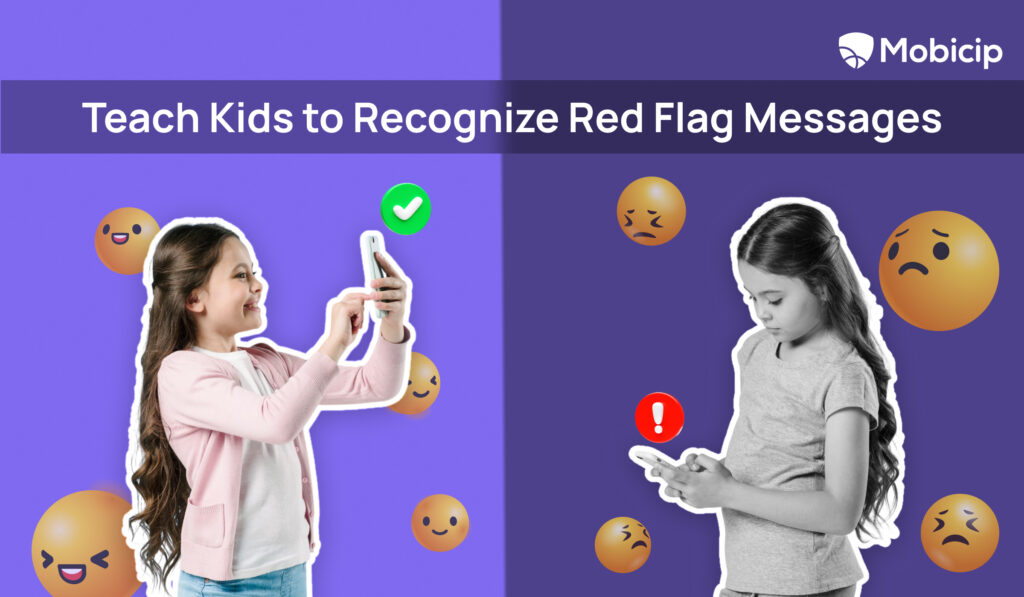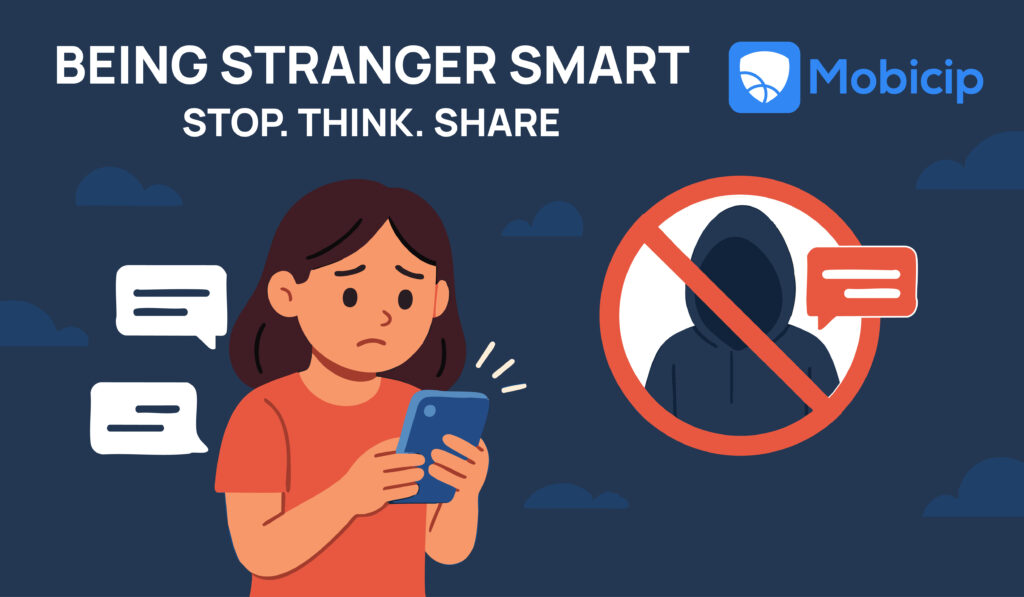How to Teach Kids to Recognize Red Flag Messages

In potboilers or blockbusters, the villain is often easy to spot. They speak in a sinister tone, wear dark clothes, or have a menacing look that makes us immediately think, “That’s trouble.” Whether it’s Voldemort’s sly whispers or President Snow’s icy glare, the bad guy’s characteristics are usually exaggerated, giving us a clear visual or auditory cue to watch out for. But in real life, especially online, danger is far less obvious. The red flags are subtle, hidden behind friendly messages, flattering compliments, or harmless-sounding jokes. The predator might seem just like a friend—or worse, like someone you already know.
Teaching children to recognize these red flag messages is essential in today’s digital age. Without the right tools, kids may easily be drawn into unsafe situations, sharing personal details or falling victim to online manipulation. As digital citizens, kids need to understand how to identify suspicious or dangerous behavior, ensuring they can navigate the online world safely and confidently.
In this post, we’ll walk you through how to teach your children to spot red flags and protect themselves from online threats. We’ll also explore how Mobicip can help you monitor and manage their digital environment for an added layer of security.
Understanding Red Flag Messages
Red flag messages are warning signs of potential danger or harm in digital communication. These messages often come from unreliable sources and may be designed to manipulate, deceive, or exploit the recipient. Kids must recognize these messages to avoid falling into risky situations online.
Common types of red flag messages include:
- Scam messages: These are deceptive attempts to steal personal information, often disguised as prize notifications, fake job offers, or urgent requests for money.
- Inappropriate messages: Messages that contain harmful or explicit content, such as cyberbullying, inappropriate language, or sexually suggestive material.
- Messages from strangers: Communications from unknown individuals, especially those asking for personal information, meeting in person, or engaging in conversations that make the child uncomfortable.
Why Children Are Vulnerable to Deceptive Online Communication
Children have always needed guidance to navigate social cues, relationships, and complex situations in the real world. Today, much of their world is in the digital domain, and this new realm brings both opportunities and challenges. The internet offers learning and fun but also exposes children to potential dangers.
The online world lacks the immediate, physical cues that usually help children identify safe versus unsafe situations. Children often interact with strangers or come across content they may not fully understand. Their natural curiosity and desire for social validation can lead them to engage with harmful or misleading messages. Without the maturity to critically evaluate what they encounter online, children are more vulnerable to deceptive communication that can exploit their trust and lack of experience.
The Impact of Red Flag Messages on Children
Children’s brains and behavior are shaped by the experiences they have as they grow. Every interaction, every bit of information they absorb, plays a role in how they perceive the world and themselves. Therefore, it’s crucial that they be exposed to content that fosters positive growth—content that builds confidence, empathy, and critical thinking—rather than material that degrades their sense of self or understanding of the world. The foundation laid during childhood can last a lifetime, affecting their emotional and psychological well-being.
Psychological and Emotional Effects of Exposure to Harmful Messages
Exposure to harmful or inappropriate content can have significant psychological and emotional effects on children. It can alter how they view themselves, their relationships, and their place in the world. Some of the effects include:
- Anxiety and fear: Constant exposure to disturbing or violent content can make children fearful or anxious, causing them to feel unsafe or unable to trust others.
- Low self-esteem: Inappropriate messages that promote unrealistic beauty standards or harmful behavior can lead to a negative self-image and poor self-worth.
- Desensitization: Repeated exposure to violent or distressing content can lead children to become desensitized, making them less empathetic toward others’ suffering or more accepting of harmful behaviors.
- Confusion and fear of judgment: Kids may also feel confused about social norms or pressured to conform to unrealistic expectations, leading to a struggle with identity and belonging.
How Misleading or Manipulative Messages Can Influence Children’s Behavior
Misleading or manipulative messages can shape children’s behavior in unhealthy ways, particularly if they are targeted at vulnerable emotions or desires. These types of messages often exploit a child’s sense of curiosity or desire to fit in. Some potential influences include:
- Manipulative messages can convince children to engage in unsafe actions, such as sharing personal information or meeting strangers offline.
- Messages pressuring kids to join viral challenges or harmful trends can lead them to make unsafe, unhealthy decisions online.
- Harmful content can subtly normalize behavior such as bullying, substance abuse, or even self-harm and desensitize kids to them.
Other impacts of exposure to inappropriate content can include a lack of trust in authority figures, a diminished ability to form healthy relationships, or even a skewed sense of reality that makes it harder to distinguish between fiction and real-world consequences.
Teaching Kids to Identify Red Flags
Guiding children to recognize red flag messages is crucial to their safety in the digital world. As they navigate online spaces, they need to develop the skills to identify warning signs of potential danger. Teaching them these skills early on can help prevent them from falling victim to harmful interactions.
Start Early: Introduce Digital Literacy at a Young Age
In some cultures, expectant mothers talk to their unborn children, hoping to impart wisdom even before birth. While we may not be having full conversations with unborn babies yet, starting digital literacy early can offer similar benefits. Furthermore, since kids are surrounded by screens almost from birth, teaching them to understand the digital world early on helps set a solid foundation for recognizing safe versus risky online content. By making digital literacy as natural as learning the ABCs, we prepare them to handle the complexities of the internet with confidence.
Encourage Critical Thinking: Teach Kids to Question Red Flag Messages
One of the most powerful tools in digital safety is critical thinking. Encourage kids to ask questions when they receive messages that seem strange or too good to be true. Also teach them to pause before acting—whether it’s clicking on a link or responding to an unsolicited message. By doing so, they will develop the habit of questioning suspicious messages, making them more likely to recognize when something doesn’t add up.
Roleplay Scenarios: Practice Real-Life Examples of Red Flag Messages
Practice makes perfect, and the same applies to online safety. Use roleplay to simulate real-life scenarios where kids might encounter red flag messages. You can act out situations where someone asks for personal information or tries to pressure them into something uncomfortable. Teach kids to recognize manipulative language like flattery, urgency, or threats. This helps them spot red flags when they encounter them in real life.
Spot the Fake: Engage Kids in Identifying Misinformation and Scams
Help your kids become online detectives by engaging them in identifying fake news, scams, or misleading advertisements. Show them how to spot red flags like overly dramatic headlines, strange links, or too-good-to-be-true offers. The more they practice distinguishing fact from fiction, the better equipped they’ll be to handle deceptive content they encounter online.
Safe Communication Practices
Make sure kids understand the importance of keeping personal information private. Teach them to avoid sharing sensitive details like their full name, address, school, or phone number with strangers. Set clear rules about who they can communicate with online and when it’s appropriate to block or report someone.
Discuss the Importance of Open Conversations About Red Flag Messages
Finally, create an open dialogue about online safety. Encourage kids to come to you with any concerns they may have about messages they’ve received or interactions they’ve had online. Reassure them that they won’t get into trouble for speaking up and that their safety is the top priority. Regularly check in with them about their online experiences, and make sure they know you’re always there to help.
Tools and Resources for Parents
Parents don’t have to navigate the complexities of digital safety alone. There are many tools and resources available to help guide children through the online world, ensuring they can enjoy its benefits while staying safe from potential harm.
Apps and Tools That Help Filter Harmful Content
Mobicip
Mobicip is a powerful parental control app that helps parents monitor and manage their children’s online activity. It allows you to filter content, set time limits, and block harmful sites, helping create a safe online environment for your kids.
Key Features of Mobicip:
- Web filtering: Automatically blocks harmful websites and inappropriate content based on adult content, violence, and gambling categories.
- Screen time management: Set daily screen time limits and schedule breaks to prevent excessive device use.
- App monitoring: Track app activity and block dangerous apps, ensuring your child’s device is only used for educational or entertainment purposes.
- Location tracking: Know where your child is in real-time to ensure their safety.
- Activity reports: Receive detailed reports of your child’s online activity, helping you spot any potential red flags.
Mobicip makes it easy for parents to stay informed and take action when they notice suspicious activity, such as interactions with strangers or access to inappropriate content. By utilizing these features, parents can protect their children from deceptive or manipulative online messages.

Other Helpful Apps That Can Help in Identifying Red Flag Messages
- Qustodio: Offers web filtering, app monitoring, time management, and location tracking. Great for keeping track of social media activity and preventing access to harmful content.
- Norton Family: Provides web monitoring, search supervision, and detailed activity reports, helping parents manage what their kids view and search for online.
- Kaspersky Safe Kids: Features include web filtering, app monitoring, and real-time location tracking, with added tools for monitoring social media interactions.
These apps, alongside Mobicip, give parents the tools they need to actively guide their children through the online world, ensuring they can enjoy the benefits of technology while avoiding potential red flag messages and harmful content.
Practical Tips for Setting Up Safe Online Environments
Here are 10 practical tips for ensuring a safe online environment for your kids:
- Teach kids about ethical online behavior and the importance of digital responsibility.
- Set up parental controls on devices and apps to block inappropriate content.
- Encourage kids to report suspicious or harmful messages immediately.
- Limit screen time and monitor online activity regularly.
- Help kids understand the consequences of sharing personal information online.
- Educate kids about the risks of talking to strangers on the internet.
- Make sure kids know they can always seek help from trusted adults when something feels off.
- Keep devices in common areas to better monitor usage.
- Establish rules for safe online gaming and social media use.
- Regularly have open discussions with kids about their online experiences and concerns.
Conclusion
Keeping kids safe online is a continuous responsibility that requires guidance, vigilance, and proactive steps. Teaching children to spot red flag messages is essential for empowering them to make wise decisions in an increasingly digital world. By introducing them to digital literacy, encouraging critical thinking, and using helpful tools like Mobicip, parents can create a strong foundation for online safety. While the internet offers countless opportunities, ensuring children understand how to recognize and respond to potential threats will help them navigate these spaces with confidence and security.





